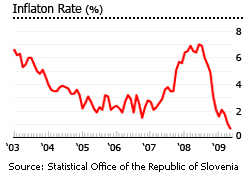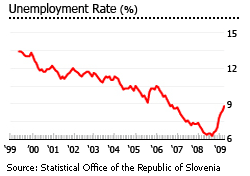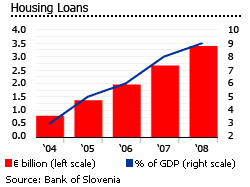Slovenia’s banking problems drag house prices down

New bank lending has virtually ground to a halt in Slovenia, due to banking system problems. As a result, the house price increases during the first quarter of 2010, which were very small anyway, have not been sustained.
Slovenia’s mortgage market expanded rapidly from 2004 to 2008, largely due to strong economic growth and low interest rates. But many housing and consumer loans turned sour when the 2009 economic recession hit. Bad loans rose from 1.7% of the banks’ portfolio in 2007, to 3.2% in 2010, according to the Central Bank. Slovenia’s three biggest banks reported losses in 2010. As a result, bank lending almost ground to a halt during the last quarter.
In Ljubljana, the capital, advertisement-based property prices have been either stagnant or slightly falling since 2008, according to slonep.net, the most comprehensive real estate portal in Slovenia.
- The average price of houses in Ljubljana fell 3.5% during 2010, to €1,897 per sq. m.
- The average price of Ljubljana suburban houses was €1,332 per sq. m., down 2.7% from a year earlier.
- The average price of apartments of 3 bedrooms or less was around €2,734 per sq. m., down by 0.8% on the previous year.
Family houses suffered more than apartments in terms of price falls.
- The family house price index fell 6.3% during the half year to Q3 2010, and was 2.4% down from the same period last year.
- Apartments fell 0.8% during the half year to Q3 2010, but were up 4.2% from a year earlier.
Property prices in Slovenia had risen rapidly from 2004 to 2007, due to strong economic growth, low interest rates, and the rapid expansion of the mortgage market. The average price of second-hand dwellings rose 16.7% annually during the period on average, according to SORS.
Strong growth in the past

Slovenia, a small country, with only about 2 million people, experienced strong economic growth from 2000-2007, with an impressive average GDP growth rate of 9%.
In 2004, it made the transition from being a World Bank borrower, to being a donor-partner. During the following three years, Slovenia’s GDP grew to €36 billion in 2007, from €27 billion in 2004.

Slovenia’s economy is driven by exports, which account for 70% of GDP. After its accession to the European Union in 2004, it became even more open to trade with other EU member countries, and exports grew at an average rate of 14.5% during 2004-2007. Most exports are to Germany, Italy, Croatia, Austria, France and Russia. The manufacturing sector accounts for most employment. In the last few years, there has also been a huge increase in tourist visits to Slovenia.
Wages rose 3.6% in 2005, and 4.1% in 2007. Inflation stayed below 4% from 2004 to the third quarter 2007. Unemployment fell to 6.43% in Q3 2008, down from 13% in 1999, but shot up again to 11.1% in November 2010. The rate is expected to continue rising. The government reported that the number of unemployed increased 15.6% y-o-y to January 2011.
Cautious mortgage market
Slovenia’s mortgage market is still relatively small, at 9% of GDP in 2008, but has been growing rapidly, and is up from 3% in 2004.

There are no special mortgage banks in Slovenia, though 19 commercial banks and 3 savings banks offer mortgages. Nonetheless, 233 banks from European Economic Areas (EEA states) are authorized to perform mortgage services directly in Slovenia or through a branch. The average loan-to-value ratio is 50%, i.e., households have to cough up a 50% down payment to qualify for a mortgage.
Slovenia’s mortgage market, though improving, plays a weak role in housing finance, according to Matej More of the Finance Ministry. The reason is the underdevelopment of land registration system, the foreclosure procedure, and other problems in the legal environment.
Mortgages are secured on property bought in Slovenia, not on property outside the country. Normally, a 10% deposit is required to secure a property. According to Slovenian law, if the seller backs out, he is liable to pay twice the deposit.
Housing loans with interest rates fixed for 5 to 10 years or more are now available, but almost 82% of loans in 2008 were variable rate, according to the Bank of Slovenia.
Interest rate movement
After Slovenia’s accession to the European Union in 2004, interest rates fell to an average of 5% in 2006, from 10% in 2003. However, in 2007 they started to rise again to 6%, and then to 7% in 2008, almost the same as the 10 years fixed-rate mortgage rate.
Lukewarm foreign demand

Slovenia’s real estate market has been completely open to EU nationals since it joined the EU in 2004. This was expected to usher in thousands of EU citizens eager to buy properties in Slovenia, but only a handful came, due to higher real estate prices in Slovenia compared to other EU countries, according to Sonja Gračanić of Dodoma Real Estate.
“When you explain to them (potential buyers) the realities, when they look at the prices… which are not that cheap… and mostly they’re thinking about renting it out and getting some money. And when they work out what they get in rent, it doesn’t actually add up,” said Diana Evans, a Briton who was among the first wave of foreign land buyers in Slovenia. Slovenia’s very short coastline is another negative.
During the first year after liberalization, only about 500 properties were sold to EU citizens. And from January 2006 to April 2009, foreigners bought only 2,026 properties according to the Slovenia Tax Administration (DURS). Most buyers were from United Kingdom (39%), Italy (29%), Austria (8%) and Germany (6%). Only two banks offer mortgages to foreign investors. One is the Volksbank of Austria, which offers 70% mortgages. The other is SKB Banka, which offers up to 50% mortgage credit.
Even before the recent house price boom, rental yields in Slovenia were relatively low.
In July 2008, rental yields for properties in central Ljubljana ranged from 4.3% to 5.5%, according to the Global Property Guide. Property prices were around €2,926 to €3,737 per sq. m. while rents are around €491 per month for a small (40 sq. m.) unit. Larger units have much higher rents that can reach up to €2,175 per month (for a 150 sq. m. flat).
Most Slovenes own their houses; the owner-occupancy rate was 82% in 2005.
Economic slowdown
Slovenia’s economy is fueled by exports and foreign investments, and its high level of trade openness made Slovenia sensitive to the global economic crisis. To a great extent, economic growth is largely dependent on the movements in its exports, primarily to its main trading partner, Germany, which constitutes around 19% of Slovenia’s exports.
Slovenia’s GDP grew by 1% in 2010, with increased exports to Germany the only contributor to growth - a significant improvement, however, compared to the economy’s 8.1% contraction in 2009, its worst crisis since independence.
Slovenia’s recovery is expected to remain weak, with economic growth of around 1.7% to 2% in 2011
The government’s ability to pump prime the economy is hampered by the limits set in the eurozone. From a balanced budget in 2007, the budget deficit rose to 5.4% in 2010. In line with the EU deficit limit of 3% of GDP by 2012, Slovenia is planning to bring its deficit down to 4.7% in 2011.
In 2010, the government froze public sector wages and proposed radical reforms to the labor market and revisions to the pension system. The plans failed to push through, as unions demanded a referendum on pension reforms. The pension reform plan is now pending in parliament.